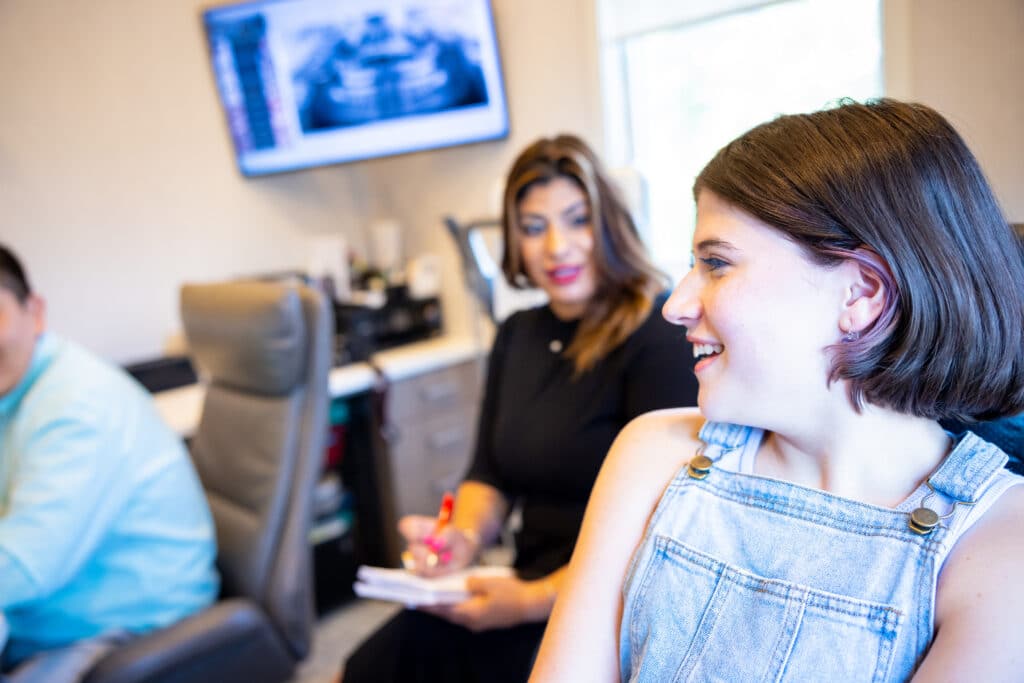Braces and clear aligners have straightened thousands of sets of teeth, but they don’t always do it alone. They often get help from rubber bands, sometimes called elastics. Orthodontic rubber bands are definitely different from the ones you’re used to seeing. These are specially made to be in your mouth and to help your braces or Invisalign straighten out your misaligned bite.
We hear many questions about rubber bands or elastics here at Sacks Orthodontics. Are elastics safe for me to use? What’s the point of elastics on braces? Do rubber bands hurt? They’re great questions, and we’re happy to answer those questions and more.

It’s very common to use rubber bands with braces or Invisalign to repair a misaligned bite. Elastics are used to improve the moving power of braces or Invisalign. These rubber bands are different from the tiny, colored elastics that go around brackets of braces. These elastics are larger and are placed in the mouth by the patient instead of the orthodontist. Tiny posts on certain brackets hold the rubber bands in place. Invisalign can also use these rubber bands, which fit over tiny buttons added to the clear aligners to hold the elastics.
Dental rubber bands aren’t your typical rubber bands. These are made with medical-grade latex that is non-toxic and is designed to put just the right amount of pressure on your teeth and jaws. For those with latex allergies, there are non-latex versions of dental elastics. Let your orthodontist know if you have such an allergy.
We have several sizes of rubber bands. The ones you use will be determined by how much we need to move your jaw and how far the elastics need to stretch. The different elastics for braces apply different levels of pressure and move the teeth in certain ways to fix underbites, overbites, crossbites, and gapped teeth and realign the jaw, among other things.
Rubber bands for braces come in three main classes, and each class has a certain function in your treatment.
When do you start wearing rubber bands for braces? At Sacks Orthodontics, we provide our patients the correct rubber bands. We will show you how to put them on your teeth in our office and give you instructions on when you need to wear them for your individual treatment. At first, you’ll probably wear them all the time except when eating or brushing your teeth. Eventually, we may change it so you’re wearing elastics only at night.

Wearing rubber bands with braces is pretty easy, but there are a few “dos” and “don’ts” to keep in mind.

It may take a little time to get used to wearing elastics with your braces or Invisalign. You may wonder how to put on elastics properly because there is a certain pattern to treatment with rubber bands. We will show you how to put your rubber bands on your braces. Over time, we may have you change the types and positions of the rubber bands. You’ll get used to stringing the elastics over the posts or buttons on your braces or Invisalign. Pretty soon, you’ll be an expert-level elastics wearer!
So how long will you wear your elastics? As far as overall treatment, it varies from patient to patient. It will depend on how severe the dental issue is as to whether you will need elastics during part or most of your treatment.
How long per day do you have to wear your elastics? Usually, we recommend you wear them all the time at first. If you have some discomfort, usually Tylenol will take care of it. The discomfort should disappear after a few days.
These elastics are tough and stronger than regular rubber bands. However, there may be an occasion or two where you might get a dud and it breaks. Don’t worry if that happens! Simply remove what’s left and replace it with a new one. If it pops in your mouth and makes a sore spot, rinse your mouth with warm salt water, and that should make it feel better.

Elastics play a vital role in treatment with braces or Invisalign. We hope we’ve answered your questions about elastics, but if not, we’re here if you have more! If you’re in the Livingston, NJ, area, you can start with a free virtual consultation or request an in-person consultation. Either way, the consultation is without obligation!
